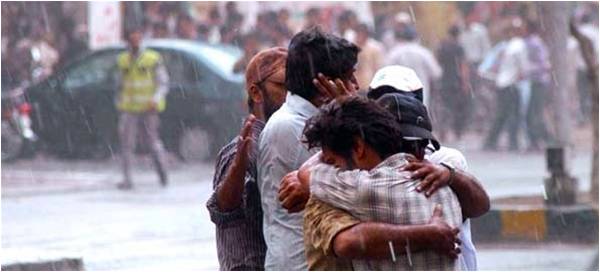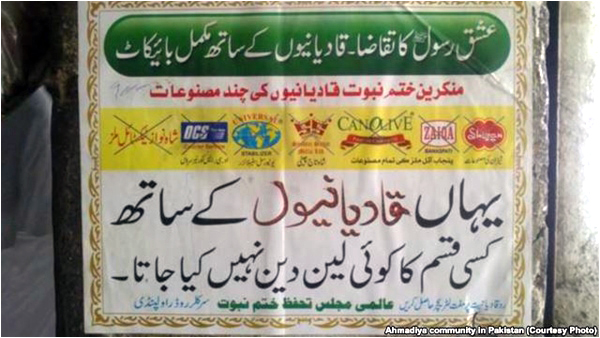
A mob of 600 angry men killed three people, torched five homes and destroyed numerous shops belonging to the minority Ahmadiyya community in Gujranwala, Punjab on July 27 owing to an Ahmadi man allegedly posting a ‘blasphemous’ image on Facebook. The exact details of the image are neither substantiated nor relevant. For, an allegation of blasphemy is above law in Pakistan. It took down the governor of the country’s most powerful province, without a whimper.
Three Ahmadi teenagers have been accused of blasphemy for protesting against a poster that defamed their community and six other Ahmadis were charged with blasphemy for allegedly tearing a calendar, in separate events in the last three months. In the same period three other Ahmadi men, including a Pakistani-American cardiac surgeon Dr Mehdi Ali Qamar, have been shot dead.
The recent surge in blasphemy accusations has meant that Pakistan’s law enforcing agencies know exactly what to do when they see an incandescent mob hankering after minority blood. The ashes from houses burnt down in Gojra and Joseph Colony, and the ensuing Christian graves, bear testament to the local police’s compliance with religiously motivated crowds. And when the mob is targeting the Ahmadis, whose ‘heresy’ has been sanctioned by Pakistan’s Constitution, letting the mob do its work becomes that much easier.
The Ahmaddiya community was ‘officially’ excommunicated in 1974 through the Pakistani Constitution’s second amendment under the premiership of Zulfiqar Ali Bhutto, as the founder of Pakistan People’s Party and a torchbearer of secularism, bowed down to the clergy’s escalating pressure. Islamist military dictator Ziaul Haq tightened the noose via Pakistan Penal Code’s Ordinance XX in 1984 which debarred Ahmadis from ‘posing as Muslims’.

This has meant that the Ahmaddiya community cannot use Islamic titles, recite the Holy Scriptures in public or use Islamic greetings or call to prayer. An Ahmadi calling the community’s ‘place of worship’ a mosque is a punishable offence according to Ordinance XX, which can result in three years of imprisonment. Article 298-C of the Pakistan Penal Code declares that an Ahmadi who “in any manner whatsoever outrages the religious feelings of Muslims shall be punished with imprisonment”.
In a country where YouTube has been banned for the past two years owing to the fact that a video ‘outraged the religious feelings of Muslims’, who in turn destroyed property, killed 20 people and wounded another 200 in ‘protest’, the ambiguous verbiage of Pakistan’s Penal Code has virtually thrown Ahmadi lives at the mob’s mercy.
The Pakistani state being party to this bigotry by incorporating Takfir (the act of a Muslim accusing another Muslim of apostasy) in the country’s Constitution, makes this blatant human rights abuse all the more abominable, especially when one considers the fact that Islamist militants like the Tehrik-e-Taliban Pakistan (TTP) use the same Takfir to justify their violence. That there is not enough noise being generated internationally against Pakistan’s barefaced religious apartheid, means that recurrence of tragic incidents like the riot in Gujranwala is inevitable.
It is common to find ‘Qadiyanis (A derogatory term for Ahmadis) not allowed’ signs in Pakistani shops, educational institutions and even district courts. Banners and hate literature declaring Ahmadis to be ‘enemies of Islam’ are ubiquitous as well. Mosques are quite often heard spewing anti-Ahmaddiya hatred through their loudspeakers, which has often been cited as an immediate source of motivation behind attacks against Ahmadis. Gujranwala was the latest example.
In February 2012, the Lahore Bar Association (LBA) led a movement against Shezan food products, because the company was allegedly owned by an Ahmadi. Hordes from the same LBA had earlier showered rose petals on Mumtaz Qadri while he was being taken to court. In September 2008, Aamir Liaquat Hussain denounced Ahmadis as wajib-ul-qatal, with two prominent members of the Ahmaddiya community being murdered in the next two days. Even the events in Gujranwala were preceded by Tahir Ashrafi justifying violence against Ahmadis on national television.
[quote]Pakistani media has played its part in the apartheid of Ahmadis[/quote]
Pakistani media has played its part in the apartheid of Ahmadis. Religious scholars hosting anti-Ahmaddiya shows on national television is a regular occurrence, with the country’s leading Urdu newspaper Jang publishing a ‘special edition’ against the Ahmaddiya Community in 2011. According to a survey by ‘Persecution of Ahmaddiya Muslim Community’, leading Urdu newspapers in Pakistan published 1,468 news stories denouncing Ahmadis as enemies of Islam and Pakistan in 2010. The same year witnessed a monstrous terrorist attack against the Ahmadis when TTP’s Punjab faction attacked two Ahmaddiya ‘places of worship’ in Lahore simultaneously on May 28, leaving 90 dead and 108 injured.
Ahmadis are quite possibly the only people that are persecuted even after they die. Their graves are regularly desecrated, with Quranic verses erased to ensure that the Ahmadi corpses don’t breach Ordinance XX by ‘posing as Muslims’. Even the tomb of the only Pakistani Nobel laureate and the first Muslim Nobel Prize winner in Sciences Dr Abdus Salam wasn’t spared whose epitaph that originally read, ‘The First Muslim Nobel Laureate for his work in Physics,’ now does not have the word ‘Muslim’.
The national hero’s birth and death anniversaries are non-events in Pakistan with Dr Abdus Salam’s religious identity being enough for the country to not celebrate his towering achievement in Physics. It is a shame that the grave of the man responsible for pioneering the unification of gauge interactions for the Grand Unified Theory now lies desecrated in Rabwah, as an emblem of Muslim disunity.
Three Ahmadi teenagers have been accused of blasphemy for protesting against a poster that defamed their community and six other Ahmadis were charged with blasphemy for allegedly tearing a calendar, in separate events in the last three months. In the same period three other Ahmadi men, including a Pakistani-American cardiac surgeon Dr Mehdi Ali Qamar, have been shot dead.
The recent surge in blasphemy accusations has meant that Pakistan’s law enforcing agencies know exactly what to do when they see an incandescent mob hankering after minority blood. The ashes from houses burnt down in Gojra and Joseph Colony, and the ensuing Christian graves, bear testament to the local police’s compliance with religiously motivated crowds. And when the mob is targeting the Ahmadis, whose ‘heresy’ has been sanctioned by Pakistan’s Constitution, letting the mob do its work becomes that much easier.
The Ahmaddiya community was ‘officially’ excommunicated in 1974 through the Pakistani Constitution’s second amendment under the premiership of Zulfiqar Ali Bhutto, as the founder of Pakistan People’s Party and a torchbearer of secularism, bowed down to the clergy’s escalating pressure. Islamist military dictator Ziaul Haq tightened the noose via Pakistan Penal Code’s Ordinance XX in 1984 which debarred Ahmadis from ‘posing as Muslims’.

This has meant that the Ahmaddiya community cannot use Islamic titles, recite the Holy Scriptures in public or use Islamic greetings or call to prayer. An Ahmadi calling the community’s ‘place of worship’ a mosque is a punishable offence according to Ordinance XX, which can result in three years of imprisonment. Article 298-C of the Pakistan Penal Code declares that an Ahmadi who “in any manner whatsoever outrages the religious feelings of Muslims shall be punished with imprisonment”.
In a country where YouTube has been banned for the past two years owing to the fact that a video ‘outraged the religious feelings of Muslims’, who in turn destroyed property, killed 20 people and wounded another 200 in ‘protest’, the ambiguous verbiage of Pakistan’s Penal Code has virtually thrown Ahmadi lives at the mob’s mercy.
The Pakistani state being party to this bigotry by incorporating Takfir (the act of a Muslim accusing another Muslim of apostasy) in the country’s Constitution, makes this blatant human rights abuse all the more abominable, especially when one considers the fact that Islamist militants like the Tehrik-e-Taliban Pakistan (TTP) use the same Takfir to justify their violence. That there is not enough noise being generated internationally against Pakistan’s barefaced religious apartheid, means that recurrence of tragic incidents like the riot in Gujranwala is inevitable.
It is common to find ‘Qadiyanis (A derogatory term for Ahmadis) not allowed’ signs in Pakistani shops, educational institutions and even district courts. Banners and hate literature declaring Ahmadis to be ‘enemies of Islam’ are ubiquitous as well. Mosques are quite often heard spewing anti-Ahmaddiya hatred through their loudspeakers, which has often been cited as an immediate source of motivation behind attacks against Ahmadis. Gujranwala was the latest example.
In February 2012, the Lahore Bar Association (LBA) led a movement against Shezan food products, because the company was allegedly owned by an Ahmadi. Hordes from the same LBA had earlier showered rose petals on Mumtaz Qadri while he was being taken to court. In September 2008, Aamir Liaquat Hussain denounced Ahmadis as wajib-ul-qatal, with two prominent members of the Ahmaddiya community being murdered in the next two days. Even the events in Gujranwala were preceded by Tahir Ashrafi justifying violence against Ahmadis on national television.
[quote]Pakistani media has played its part in the apartheid of Ahmadis[/quote]
Pakistani media has played its part in the apartheid of Ahmadis. Religious scholars hosting anti-Ahmaddiya shows on national television is a regular occurrence, with the country’s leading Urdu newspaper Jang publishing a ‘special edition’ against the Ahmaddiya Community in 2011. According to a survey by ‘Persecution of Ahmaddiya Muslim Community’, leading Urdu newspapers in Pakistan published 1,468 news stories denouncing Ahmadis as enemies of Islam and Pakistan in 2010. The same year witnessed a monstrous terrorist attack against the Ahmadis when TTP’s Punjab faction attacked two Ahmaddiya ‘places of worship’ in Lahore simultaneously on May 28, leaving 90 dead and 108 injured.
Ahmadis are quite possibly the only people that are persecuted even after they die. Their graves are regularly desecrated, with Quranic verses erased to ensure that the Ahmadi corpses don’t breach Ordinance XX by ‘posing as Muslims’. Even the tomb of the only Pakistani Nobel laureate and the first Muslim Nobel Prize winner in Sciences Dr Abdus Salam wasn’t spared whose epitaph that originally read, ‘The First Muslim Nobel Laureate for his work in Physics,’ now does not have the word ‘Muslim’.
The national hero’s birth and death anniversaries are non-events in Pakistan with Dr Abdus Salam’s religious identity being enough for the country to not celebrate his towering achievement in Physics. It is a shame that the grave of the man responsible for pioneering the unification of gauge interactions for the Grand Unified Theory now lies desecrated in Rabwah, as an emblem of Muslim disunity.

